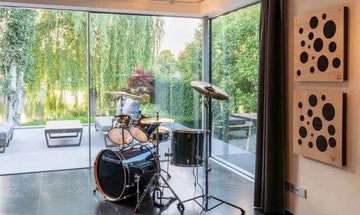Effective communication is the cornerstone of successful meetings, and the acoustics of your meeting rooms play a crucial role. Good acoustic treatment not only improves sound clarity but also ensures privacy, increases productivity, and creates a more comfortable environment for all participants.
Understanding acoustic treatment
Acoustic treatment involves adjusting the structure and materials of a space to regulate sound behavior. This includes reducing reverberation, minimizing echoes, and preventing sound leakage. By addressing these factors, you can achieve clearer communication and a more pleasant listening experience. citeturn0search0
Key benefits of acoustic treatment in meeting rooms
Improved speech intelligibility: Good acoustics ensure that every word is heard clearly, reducing misunderstandings and the need for repetition. This is especially crucial in meetings where accurate information sharing is essential.
Enhanced privacy: Acoustic treatments help reduce noise in the meeting room and prevent sensitive discussions from being overheard. This is essential for maintaining confidentiality and complying with privacy regulations.
Less distraction: By minimizing external noise and controlling internal sound reflections, acoustic treatments create a more focused environment, allowing participants to concentrate better and participate more effectively.
Increased productivity: Clear communication and a comfortable auditory environment contribute to more efficient meetings, leading to better decision-making and higher productivity.
Common acoustic challenges and solutions
Reverberation: Excessive echo can hinder speech intelligibility. Installing sound-absorbing materials such as acoustic panels can help reduce this problem.
Sound leakage: Noise from adjacent rooms can disrupt meetings. Implementing soundproofing measures, such as sealing gaps and using heavy curtains, can reduce this problem.
Background noise: External sounds can disrupt meetings. Using white noise machines or sound masking systems can help mask these distractions.
Implementing acoustic solutions
When planning acoustic treatments, consider the following:
Room layout: The size and shape of the room influence sound distribution. Strategic placement of acoustic treatments can optimize sound quality.
Material selection: Choose materials that complement the aesthetics of the space while also providing effective sound absorption. Options include acoustic panels, ceiling islands, and diffusers.
Professional Assessment: Consulting with an acoustics specialist can provide customized solutions based on the specific needs of your meeting room.
Conclusion
Investing in acoustic treatments for your meeting rooms is a strategic move that improves communication, ensures privacy, and increases productivity. By addressing common acoustic challenges and implementing effective solutions, you create an environment conducive to successful and efficient meetings.





